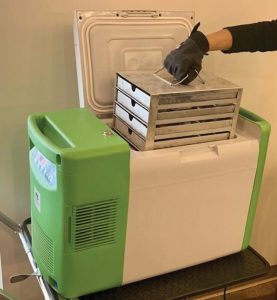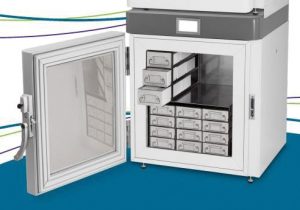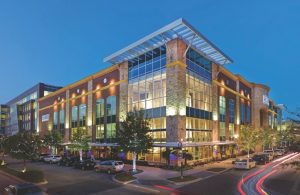— By Cedar Blazek —
Two major businesses effectively meet and exceed energy-efficiency goals despite COVID-19 challenges.
It’s no secret that the onset of the COVID-19 pandemic in March of 2020 brought everything to a screeching halt. Nearly overnight the world was in lockdown, businesses shuttering — some temporarily, some for good — as the overarching “What do we do now?” question blanketed the economic landscape.

Cedar Blazek, DOE
The pandemic forced widespread shutdowns across sectors and challenged essential businesses to adapt quickly as consumer traffic changed and public health protocols tightened. Many companies had to put sustainability goals aside to shift their focus to pandemic response.
Across many companies, facilities and energy teams worked tirelessly to ensure customers could shop and essential team members could work safely. At the same time, they needed to ensure that new guidelines and tightened budgets would not curtail their previous energy-efficiency efforts. Adaptability and innovation were key characteristics for companies transitioning to a post-pandemic model of operations, and essentially, companies had to learn to do more with less.
This article takes an inside look into two large but diverse companies — Walgreens and Life Time — that are committed partners in the Better Buildings Initiative through the U.S. Department of Energy (DOE). From total shutdown to quickly learning how to operate during a pandemic, these two companies offer insights into solutions that at once helped them respond to unforeseen events and keep their energy goals on target. The lessons learned by these companies may prove beneficial for other businesses facing similar obstacles, now or in the future.
What is the Better Buildings Initiative?
Through the Better Buildings Initiative, DOE partners with public and private sector organizations to make commercial, public, industrial and residential buildings more efficient, thereby saving energy and money while creating jobs.
 Collectively, Better Buildings Initiative partners have saved more than 2.2 quadrillion Btus of energy, equivalent to more than $13.5 billion, and more than 130 million tons of carbon dioxide. Partners have also reduced their water use by more than 10 billion gallons. Together, partners represent more than 30 of the country’s Fortune 100 companies and 12 of the top 25 U.S. employers. Partners also include eight national laboratories and more than 80 state and local governments spanning the nation.
Collectively, Better Buildings Initiative partners have saved more than 2.2 quadrillion Btus of energy, equivalent to more than $13.5 billion, and more than 130 million tons of carbon dioxide. Partners have also reduced their water use by more than 10 billion gallons. Together, partners represent more than 30 of the country’s Fortune 100 companies and 12 of the top 25 U.S. employers. Partners also include eight national laboratories and more than 80 state and local governments spanning the nation.
With the support of DOE through the Better Buildings Initiative, Walgreens and Life Time were able to adapt to pandemic-related changes while maintaining their energy-saving initiatives and becoming better prepared for future challenges.
Walgreens Adopts Smarter Operations
Deemed an essential business, Walgreens, a pharmacy, health and beauty company, continued operations during the COVID-19 pandemic, but with strict safety protocols in place — which included increased sanitation measures, shortened operating hours, and limited in-store customer counts. Walgreens quickly altered procedures to maintain business while allowing in-store shopping and keeping customers and employees safe. The company moved to immediately offer services through its existing pharmacy drive-thru windows, added curbside pickup service, improved online ordering. and provided delivery in some areas.
Re-Thinking Smart Energy Goals
Throughout the pandemic, Walgreens rallied to provide essential products and services to communities across the U.S., all while continuing to show leadership in energy efficiency. Walgreens was recognized by DOE in spring 2021 for achieving its 20% energy-intensity improvement goal through the Better Buildings Challenge, a program within the broader initiative.
 To reach this goal, Walgreens focused on upgrading HVAC equipment and lighting. In 2019, the retailer was recognized by DOE’s Interior Lighting Campaign for implementing the largest number of projects and achieving the largest portfolio-wide energy savings among applicants, realizing an annual electricity savings of 54 million kWh — enough to power more than 5,000 U.S. homes for a year.
To reach this goal, Walgreens focused on upgrading HVAC equipment and lighting. In 2019, the retailer was recognized by DOE’s Interior Lighting Campaign for implementing the largest number of projects and achieving the largest portfolio-wide energy savings among applicants, realizing an annual electricity savings of 54 million kWh — enough to power more than 5,000 U.S. homes for a year.
Because the work was mainly outside, HVAC replacements continued largely uninterrupted during the pandemic. However, continuing the LED indoor lighting program would have been disruptive to operations and would have demanded extra shifts in the stores during the early weeks of the pandemic. Working closely with its partners and vendors, Walgreens was able to complete 80% of all lighting retrofits between June and August 2020. This was only possible because of the long-standing business relationships and open communication among all stakeholders in the program.
Planned refrigeration upgrades were also paused in spring 2020. Walgreens had completed surveys for many high-traffic stores to upgrade refrigeration equipment and was about to proceed with installations when the pandemic began. The company re-surveyed and shifted the work to stores with less foot traffic, where impact could be minimized. Under the new plan, Walgreens was able to complete the majority of the 2020 refrigeration replacements.
Walgreens was also an essential partner in helping the country with COVID-19 efforts. After the initial changes to store operations, the engineering team quickly pivoted to support COVID-19 testing and later to vaccine storage and distribution. Because of the extremely low temperatures required to safely store some vaccines, energy use was one of many priorities. The team partnered with utility representatives to gather data on electricity reliability and outage history to identify suitable vaccine storage and distribution locations.
Life Time Survives Total Shutdown
On the other end of the spectrum, some businesses, like fitness centers, were ordered to cease operations due to the pandemic.
One such example is Better Buildings Challenge partner, Life Time, which operates more than 150 health clubs in the U.S. and Canada. With large facilities that operate 20+ hours per day, 7 days a week, Life Time’s buildings management team proactively implemented measures to recalibrate its building management systems to avoid potential energy waste.
 Life Time analyzed data for its more than 18 million square feet of building space through its energy management system (EMS) platform and addressed any issues with limited staff. Life Time’s director of energy management & sustainability, Peter Isabell, explains: “While it certainly was a difficult period for our business, COVID also presented us with the opportunity to learn more about our buildings through closures and reopenings. Our operations staff not only ensured our clubs were maintained and safe, but also assisted in our efforts to control energy usage.”
Life Time analyzed data for its more than 18 million square feet of building space through its energy management system (EMS) platform and addressed any issues with limited staff. Life Time’s director of energy management & sustainability, Peter Isabell, explains: “While it certainly was a difficult period for our business, COVID also presented us with the opportunity to learn more about our buildings through closures and reopenings. Our operations staff not only ensured our clubs were maintained and safe, but also assisted in our efforts to control energy usage.”
During the pandemic closure period, Life Time’s team also rescheduled over 5,000 pieces of equipment, reducing over 86 million kWh of electricity, 6.5 million therms of natural gas and 600 million gallons of water.
An Ongoing Commitment to Smart Energy
With the lifting of pandemic restrictions in most of its markets, most Life Time locations have since reopened with ongoing, extensive cleaning protocols, including measures taken during nighttime closures at most facilities. This has allowed Life Time to undertake a commissioning process to shut down additional systems at night — saving even more energy and ensuring its clubs are operating as efficiently as possible, while also ensuring positive building pressure and enhanced circulation/filtration.
The Future Is Bright
As businesses gradually resume pre-pandemic operations, there are many clean energy solutions and energy efficiency adaptations that companies will continue to implement. Pandemic-related energy and cost-saving measures have proven effective and worthwhile, benefiting the environment, businesses and consumers alike.
The Walgreens and Life Time case studies demonstrate that through innovation, creative problem solving and support from DOE, businesses can not only survive but thrive during challenging times.
Learn more about Walgreens’ and Life Time’s involvement in DOE’s Better Business Initiative as well the Initiative’s market-tested strategies for energy efficiency and decarbonization at the Better Buildings website.
— Cedar Blazek is a management and program analyst in the Commercial Buildings Integration program under DOE’s Office of Energy Efficiency and Renewable Energy. Through the Better Buildings Initiative, Blazek partners with retailers, foodservice providers and grocers to adopt energy efficiency best practices.

